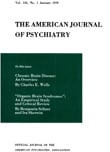Abstract
In his search of the literature for cases of a similar nature, Gilles de la Tourette was much impressed by reports of analogous syndromes in other cultures: "latah," "myriachit" and "jumping"(13). "The term latah conveys to the Malays a curious behavioral quirk, or aberration, normal, and yet not quite so."(14). The latah reaction consists of a severe startle reaction, imitative behavior, automatic obedience, and coprolalia. The victim is compelled "against his will"(15) to imitate the speech and behavior of others and to obey their commands, even though his tormentors clearly intend to degrade and ridicule him. He may even injure himself in the compulsion to mimic a self-destructive gesture only partially demonstrated by the person who "teases" him. For example, if the tormentor makes a sudden movement as if to place his hand in a fire, the latah victim may burn his own hand(16). "Myriachit" is the transliteration of a Russian word for an identical syndrome, one of a group classified as "arctic hysteria"(14, 16). The "Jumpers" of Maine, also known as "Shakers" or "Barkers," were members of a deviant Methodist sect who practiced celibacy and communal living after their migration to New England(14). Church ceremonials reached a climax of religious ecstasy at which the members of the congregation would jump, shake, roll on the floor, or crawl about on all fours, all the while barking and emitting incoherent sounds (speaking in tongues). Those who participated in these ceremonials became prey to this behavior outside the church services. Members of this sect, examined by Beard in 1880(17), exhibited violent jumping and twisting movements when startled, echolalia, and echokinesis. Beard stated: "All the Jumpers agree that it tires them to be jumped and they dread it, but they were constantly annoyed by their companions."
It has been traditional in much of the medical literature to treat maladie des tics as though it were identical with latah and its cognate disorders. This is almost certainly incorrect. Tics, the earliest and often the most striking manifestations of Gilles de la Tourette's disease, are unknown in latah, whereas the imitation phenomena, which are the core of latah reactions, are often totally lacking in maladie des tics. The coprolalia in latah always follows provocation and is never perseverative. Latah reactions (with the significant exception of "jumping") are far more common in females, maladie des tics in males. Latah is never seen earlier than late adolescence. Sudden fright is consistently cited as its precipitating cause; startle reactions are prominent. When Aberle brought 3 persons familiar with latah reactions to see case #1 of this paper, they were unanimous in concluding that maladie des tics was clearly not the same as latah(16). Yap has suggested that latah reactions are a variant of traumatic or fear neurosis to be found in cultures with limited control over the physical environment(14).
The etiology of Gilles de la Tourette's disease(2, 18-20) remains as obscure as it was in his time, though we may dismiss the notion of degeneracy, the catchall so fashionable in his day(1). Tics may be found in post-encephalitic conditions(21). They may accompany chorea, which may or may not be rheumatic in origin(22). They may be the symbolic crystallization of psychologic disturbances(23). Even when psychogenically induced, they may prove extremely refractory to psychotherapy(24, 25). Contrariwise, the organically grounded tic may be diminished, if not obliterated, by reduction in emotional tension. Consequently, arguments that reason from clinical phenomenology to hypotheses of origin must inevitably be inconclusive.
The clinical manifestations of maladie des tics are responsive to the social environment, as our cases demonstrate; yet this in no sense constitutes proof of psychogenesis. An organic substratum may be nonetheless subject to modification or control by psychologic influences, since mental phenomena are brain events with electrical fields(26). In this connection, it is instructive to recall Efron's demonstration, in a patient with uncinate fits, that the mere recollection of odors and a conditioned visual image sufficed to inhibit the fits(27).
In our experience, pharmacologic therapy, including sedatives, muscle relaxants, and tranquilizers, has been ineffective. At this stage of our knowledge, it would appear justified to continue efforts at psychotherapeutic management, despite Heuscher's admonition that the tic phenomena are defenses against an impending psychosis(20), and Mahler and Luke's warning that the release of aggressive and erotic material may "weaken the controlling powers of the child ticquer"(10). Very few of the cases reported in the literature have had a thorough trial of intensive psychologic treatment, still fewer in the early course of their disorder. At the least, psychotherapy may be of assistance to child and family in dealing with the social consequences of the illness. More hopefully, it may succeed in modifying the intrapsychic tensions that aggravate, if they do not cause, the symptoms.
Several of our patients gave evidence of symptomatic improvement associated with psychologic treatment. The one patient with an apparently total recovery had the benefit of capably administered psychotherapy at two important junctures in his life. He had parents who, after psychiatric guidance, devoted their total efforts to his recovery. They were inclined to ascribe great value to home management with its concomitant descrease in social stimulation to the patient. It is not possible to say whether these factors or still other influences were instrumental in his recovery. Nonetheless, his gratifying response supports the wisdom of attempting total psychiatric management for patients with Gilles de la Tourette's disease.

